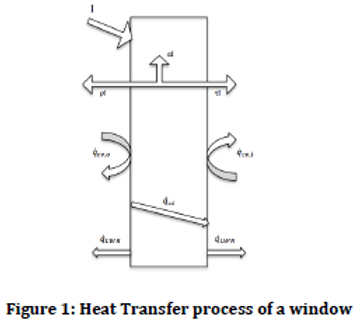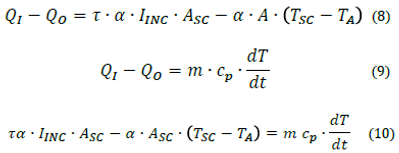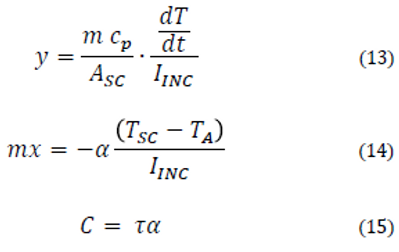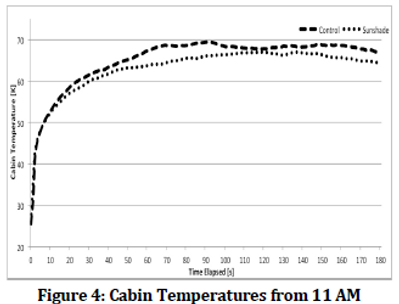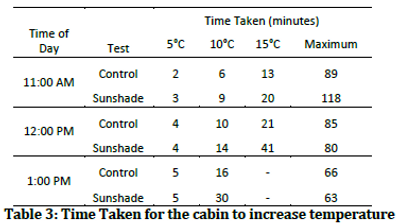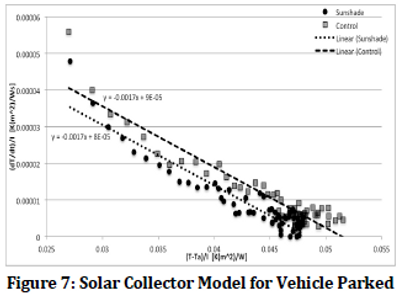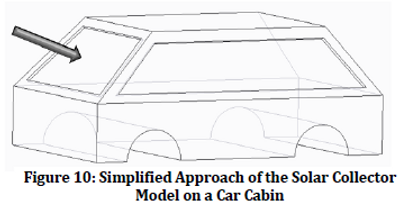Thermal Performance of Parked Cars in the United Arab Emirates
Abstract: The cabin of a car acts as a greenhouse when radiation falls on it, trapping it within the vehicle to raise the internal temperatures to lethal levels. The main aim of this report is to investigate the magnitude and the rate of temperature increase for two different parking conditions in the United Arab Emirates. The results show a maximum temperature reading of 73°C if the car was placed at 12 PM without a sunshade and a reading of 66°C when the sunshade was used and parked at the same time. The rate of temperature increase of the car were reduced slightly when a sunshade was used; the vehicle took approximately twice as long to reach 15°C higher than the initial conditions. The modeling of the cabin as a solar collector gave a fair indication of the effect of the sunshade on the car and the rate of temperature change when the vehicle was parked at different times of the day.
Key Words: Cabin temperature, heat transfer, experimental, model
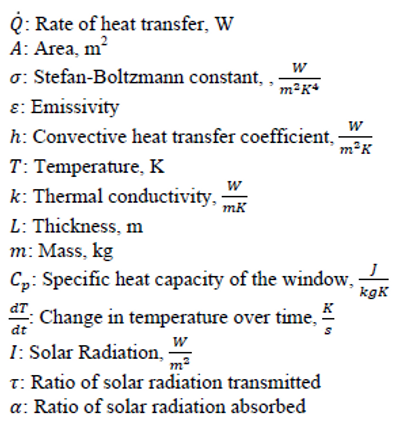
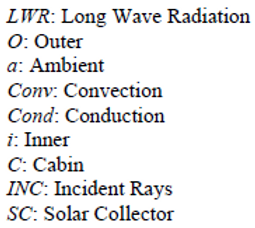
Introduction
United Arab Emirates is a popular tourist destination known for its high-rise buildings, exotic lifestyle and the yearlong sunshine. Their beaches are amongst the most popular in the GCC and attract millions of tourists every year. However, a consequence of having yearlong sunshine is the buildup of heat within the cabin of a car parked out in the open during hotter climates. Yingmeng et al. (2014) [1] used simulation and experimental methods to claim that the temperature of the cabin can reach up to 70°C when the vehicle is parked under direct sunlight. Such extreme temperatures can cause a great deal of discomfort to the passengers when returning to the parked car. The passengers are often forced to wait outside the car until the temperature of the cabin cools down to a more tolerable level. To increase the rate of temperature decrease in the car cabin, users often roll down the car windows and/or run the HVAC system of a car, often to a full setting. This leads to increase in fuel consumption by the car, as it is the source of energy to drive the compressor belt.
A reduction in cabin temperature will reduce the load on the HVAC system, making the car more energy efficient. This was the inspiration behind Al-Kayiem et al. (2010) [2] and was achieved by experimenting six different parking conditions i.e. different window settings, front shield shading and normal parking conditions to observe a reduction in temperature of the cabin. They claim a reduction of about 27% when using a front windshield reflector and about 20% by dropping the front side windows by 20mm.
I.R. Dadour et al. (2011) [3] aimed to develop an accurate predictive model to estimate the time of death of individuals in enclosed vehicles. They conducted more detailed experiments than Al-Kayiem et al. (2010), where the car was placed in different orientations to determine the effect of orientation, compared cabin temperatures of cars with different exterior paint colors and determined the ventilation effects with different window settings. The results of the experiments indicated a reduction in cabin temperature of 5°C for the white car compared to the black car. It also showed the effect of ventilation with different window settings, which resulted in a decrease of about 10°C when the windows were open by 5cm compared to when all the windows were closed.
Ozeki et al. [4] explored a different approach by investigating the spectral properties of glass and how differences of transmissive and reflective performance of the glass can affect the thermal comfort of passengers. They found that by using solar reduction glass, the solar radiation absorbed by the whole body could be reduced by 15%, thus reducing the temperature of the cabin. This also leads to an increase in the level of comfort for the passengers and a reduced load on the HVAC system.
Another reason to investigate the heat in a parked car is to increase awareness of the dangers of leaving children and pets unattended in parked cars. According to Saidur at al. (2008) [5], from 1998 to 2002, 29 children a year died of heatstroke after being left unattended in a car in the United States. The figure eventually rose to 35 children in 2004. In the United Arab Emirates, Dubai Police reported finding 119 cases of children locked in cars in 2015 alone [6]. The reason behind the high number such tragic report can be due to a lack of awareness in the magnitude of the temperature and the rate of increase of temperature when the HVAC is not running. King et al (1981) [7] found that 75% of the maximum temperature rise occurred within 5 minutes of the car door closing and rose to about 51 to 67°C within 15 minutes if the ambient temperature was 36.8°C. However, according to the Climate Yearly Report 2003-2015 by the National Center of Meteorology & Seismology in the United Arab Emirates [8], ambient temperatures in the country have risen up to 43°C in April. Thus, it is necessary to conduct similar experiments in the United Arab Emirates to have an insight into the maximum temperature and how fast it rises. Grundstein et al. (2009) [9] claim the cabin can still reach a hazardous temperature, even when the ambient temperature is at 22°C, reinforcing the need for such an experiment in Dubai, United Arab Emirates.
Although numerous experiments have been conducted on the car with different conditions such as opening in windows, orientation of the car and the color of the car. None have fully investigated the effect of placing a sunshade on the front windshield on the temperature and its rate. According to the survey conducted, a large majority of the survey group uses a sunshade when they park their cars outdoor, therefore, the effect should be investigated and compared to a control data.
Parking the car at 10 PM for 15 minutes would not necessarily have the same impact as parking it at 1 PM for 15 minutes, therefore, the report also investigates the effect on the rate of temperature increase when parking at different times of the day. It should be noted that the rate of temperature increase is equally as important as the magnitude of the temperature. The extremely high number of cases reported to the Dubai Police also implies that the public may not be aware of the dangers of leaving your child in the car for even 5-10 minutes.
Aims & Objectives
The aim of this report is the measure the cabin temperature of a car when left at different times of the day. The data will be used to create awareness by indicating how high the temperature can rise and how fast it rises especially when left at certain times of the day.
The experiment will be conducted on a specific car at the same location to avoid any other variables affecting the readings. Two different testing conditions will be carried out and compared against each other. The two conditions are control and sunshade. For the control testing conditions, no external amendments were made to the car such as window tinting, openings in windows and/or sunshade. However, the second test condition involved placing a sunshade on the front windshield, in the hope to reduce the solar radiation entering the car, thus reducing the cabin temperature.
The temperature and solar radiation for a certain period of the day was found with the use of thermocouples, data loggers and a pyranometer. Prior to the experimentation, initial readings from the car cabin and boot will also be required in order to determine whether the temperature will be safe to store the apparatus. This is especially important, as the data logger used for the readings requires a constant connection to the software and a power source; a Dell Inspiron laptop was able to fulfill the requirements of the data logger.
The experiment will be a first of its kind in the United Arab Emirates and will provide a deeper insight into the temperature of the car cabin. It can also be used to create greater awareness into the dangers of leaving children in car, hopefully, reducing the number of cases reported to the Dubai Police in the future.
Theory
Heat Transfer
Solar radiation is the energy the earth receives from the Sun on a daily basis. When solar radiation falls on the roof or the window, it is either reflected, absorbed, transmitted, or all of the above. Different windows vary in their percentage of reflection, absorption and reflection.
When the surface of either the roof or the window absorbs a certain percentage of the solar radiation, it heats up i.e. the temperature increases. It acts as a grey body and will emit radiation of it’s own. The amount of radiation depends on the temperature of the surface and the ambient temperature. Equation (1) shows the rate of heat transfer through long-wave radiation of a window:
Both, the inner and outer surfaces are in continuous contact with the environment, a different form of heat transfer occurs between the surface and the fluid (air). This type of heat transfer is called convection and can be broken down into forced and natural convection. Natural convection is induced by the differences in temperature and densities between the fluid and the object, whereas, forced convection is when the fluid is forced to blow over the surface. Equation (2) shows the relationship between the difference in temperatures of the surface and fluid and the rate of heat transfer:
Finally the last type of heat transfer that occurs on/from a body is called conduction. Similar to convection, it is caused by the difference in temperature between two adjacent surfaces; regardless of the state of the surface i.e. it can take place in solids, liquids and gases. In a car cabin, conduction normally occurs between the inner and outer surfaces of the car windows and the roof. Rate of heat transfer through conduction between two objects, 𝑄cond, can be found by using Equation (3):
In the analysis of a car, the heat transfer process does not stop on the external surface but takes place internally too. The solar radiation that is not absorbed or transmitted by the surface is transmitted within the cabin. There it is absorbed by the different surfaces such as dashboard, steering wheel, seats and etc.
As a result of conduction, the inner surface has also heated up, repeating the process of heat transfer through long wave radiation and conduction but within the cabin. This process adds to the heat that is absorbed by the air present within the cabin and the different surfaces.
This, collectively, increases the temperature of the cabin until it reaches equilibrium i.e. when the heat entering the car through the different methods mentioned above and the heat leaving the car are equal. Only until the heat transfer entering the car reduces i.e. solar radiation on the car reduces, does the temperature start to decrease. This will be evident by the graph and will correspond to the period when the solar radiation levels and the ambient temperatures tend to decrease. Figure (1) is a portion of the car window and shows the different heat transfers that take place instantaneously.
The heat transferred from the window can be found through the balance of heat arriving on the surface with the energy leaving. However, it should be noted that the overall heat transfer is the sum of the processes from all the windows, the roof, doors and etc. It is equal to the amount of energy gained by the air inside the cabin and is a function of the rate of temperature increase, as shown in Equation (4):
It should also be noted that as solar radiation is constantly changing, so is the amount of heat absorbed by all the different surfaces of the car. This in turn, has an effect on the amount of heat absorbed by the air within the cabin, thus, increasing its temperature. As the temperature of the cabin increases, it’s resistance to take on more heat along with the reduction of heat available at that certain time of day makes the difficult to evaluate and compute. Another reason the difficulty of the analytical approach is so high is the complexity of the different environmental and internal variables that directly or indirectly affect the air within the cabin and the unavailability of the physical properties of components such as steering wheel, seats etc.
Model
A solar collector is a device that captures the radiation from the sun and transfers the heat to a fluid, usually sitting below the surface. The different types of solar collectors are flat-plate and concentrating, flat-plate being the more common of the two. The main applications of flat-plate solar collectors are water heater systems at homes, pools or even in space.
Although the cabin of a car is an extremely complicated system with multiple heat transfer processes going on simultaneously, the car can be modeled as a solar collector, gradually collecting heat until equilibrium is reached. The relationship for efficiency should be similar to a solar collector for the initial stages i.e. when the temperature is rising rapidly till it reaches a steady state temperature. Figure (2) shows the significant heat transfer processes taking place on a solar collector, which will be used to derive a relationship for efficiency.
Equation (5) is the amount of heat reaching the solar collector is:
However, not all of the energy is used by the solar collector, Equation (6) is the ratio of the energy used:
The energy leaving the collector, Equation (7), is due to convection and has the relationship:
Therefore, the difference in the energy arriving and leaving the collector is the amount of energy absorbed by the fluid, which is a factor of the specific heat capacity and the mass of the fluid is shown in Equations (8-10):
Final form is given in Equation 11:
Using the equation for a straight line, Equation (12), it can be shown that if a graph of (dT/dt)/Iinc were plotted against (Tsc – Ta)/Iinc, the trend would be a negative gradient with a positive intercept.
Therefore, Equations (13-15) show the values of each of the unknowns:
This relationship, in theory, will also be true for the cabin of a car, as it is also capturing heat from the surface and distributing it to the fluid underneath the surface i.e. the air in the cabin.
Methodology
Preliminary experiments provided initial sets of readings that were required in order to justify whether the temperatures were suitable for the apparatus to be stored in. Two Tinytag© TV-4500 sensors were positioned in the boot of the car between 10 AM and 3 PM. They would then record the maximum temperature of the boot and cabin under the maximum intensity of the sun. The results showed that the boot would reach a maximum of 49.1°C, when ambient conditions were approximately 42°C. Comparing these values against the storage temperatures of all the apparatus that the experiment required; it was proved that it is safe for the apparatus to be stored in the boot during maximum intensity of the sun.
The apparatus used in the main experiment were:
Dell Inspiron Laptop
Piko USB TC-08 Data Logger
Eko MS-402 Pyranometer
x3 Type K Thermocouples
The experiment was conducted on a 2003 Honda Civic Exi with 5 doors and in ‘shoreline mist metallic’ color. The vehicle used was fully stocked and with no window tinting, seat covers or external surfaces present. This ensured fewer variables were involved in the heat transfer; thus, giving a more fair representation of how high the temperatures can rise.
The apparatus used to log the temperatures of were placed in the boot of the vehicle for the entire duration of the experiment, and the thermocouples entered the cabin through the rear seats. Similar to Grundstein et al. (2009) [9], the thermocouples were placed 15 cm from the roof at the front and 30 cm at the back. This is to simulate the temperature that would have been experienced by an adult and a child; however, the average of the two temperature readings would be used for analysis. A thermocouple was also placed outside the vehicle to record the temperature of the ambient condition. Table 1 shows the different channels used by the data logger during the experiment.
Before the start of each experiment, the vehicle was cooled using the air conditioning system for a standard 20 minutes regardless of the test time. The purpose of the cooling of the cabin was be able to simulate the conditions experienced ideally by the passenger using the vehicle prior to leaving the car outdoors. After the cooling down period, the experiment began, recording the temperature every minute for the entire test duration.
The pyranometer used was placed directly on top of the vehicle using a strong magnet. The device was used in one of the channels and recorded the voltage generated by the pyranometer itself. To calculate the actual value of radiation using the voltage logged by the data logger was through the sensitivity of the device and value recorded by the logger.
For the sunshade condition, a regular sunshade was placed on the windshield before the start of the experiment and the other conditions such as air conditioning were also conducted. The experiment was allowed to run regularly for the different times of the day to be able to investigate the rate of heat transfer i.e. with the exception of a sunshade, the procedure did not change.
Results & Discussion
Experimental
Figure (3) shows how the temperature of a cabin rises when the car is placed outdoors at 10 AM under both conditions: control and sunshade. Both the readings were started when the cabin temperatures were around 30°C and readings were recorded for 5 hours. During this period, the temperature of the cabin when in control condition rose to approximately 65°C and to 63°C when the sunshade was used.
Although the sunshade trial from 10 AM had similar starting conditions but had different maximum and the rate at which it rose to that maximum was different. Regardless of the differences, it still shares certain characteristic that makes the cabin of the car a hazardous environment for anyone. It should be noted that such high temperatures should still be deemed extremely dangerous even if a sunshade is used to reduce the magnitude.
Although the temperatures rises relatively fast, the solar radiation at 10 PM is much lower than the peak conditions, which is normally considered to be between 12 to 2 PM. The other results have much faster rates of temperature increase and can prove even more lethal when and if a child or pet is placed in a car. Figures (4-6) give a visual representation of the rate of temperature increase such that for the first 15 minutes, the graphs are vertical and stabilize when it begins to reach equilibrium. The maximum cabin temperature was 73°C and was obtained when the car was placed outdoors, with no sunshade, at noon. This is mainly due to the strong intensity of the sun at that period, which includes direct and reflected radiation. The maximum temperature was recorded after 90 minutes of the start of the experiment, corresponding to 1:30 PM, still during the peak time of the solar intensity readings.
The effect of the sunshade was relatively significant when the vehicle was parked at 12 PM, upon which, a reduction in approximately 10°C was observed. However, unlike the control trial, the temperature of around 62-65°C was maintained throughout the experiment. The reason for the temperature being constant for such a long period is the obstruction of a windshield by the sunshade from which the heat accumulated within the cabin could have transferred to the environment. It can be seen that regardless of when the car when placed, the temperatures were lower when a sunshade was placed in the windshield. The addition of a sunshade added an extra insulation for the air contained within the cabin of the car, but was unable to prevent a significant reduction.
The difference in cabin temperatures and the ambient conditions gives a clear indication into the magnitude of the temperatures in the cabin. The greatest difference is during the 11 AM experiment, when the temperatures rose by 31.0°C than the ambient in control trials. The lowest temperature increase was during the 1 PM experiment, for the control and sunshade trials, where temperature rose by 21.5°C and 22.4°C respectively. Regardless of the time the experiment was conducted, the difference in cabin and ambient temperatures was always lower for sunshade condition. Another trend with the temperature increase is for the experiments conducted later during the day, the difference between the cabin and ambient temperature decreased as evident by Table (2).
Table (3) shows the amount of time taken for the cabin temperature to rise from starting conditions by 5°C, 10°C, 15°C and the time taken to rise to the maximum temperature. As the time when the car is placed outdoors increases, the time taken to reach 5°C, 10°C & 15°C higher than the initial cabin temperatures increases. The most notable difference between the control and the sunshade condition is the time taken to increase by 15°C when parked at 12 PM; that temperature increase took the cabin twice as long as it did in the control settings.
Although solar radiation increases from 11 AM to 1 PM, the cabin temperature takes longer to increase due to the relative sun’s position at the certain time. Using the fundamentals of the sun’s position at a certain time of the day it can be shown that relative to the car, the majority of the sun’s radiation at later times is penetrating through the roof of the car, rather than the windows, which have a higher transitivity when compared to the roof.
It should also be noted that if the majority of the radiation enters through the roof, the dashboard (it should be noted that the term ‘dashboard’ includes the dashboard and other plastic components such as steering wheel, inner door surfaces etc.) is unable to absorb as much of the transmitted radiation as it would have at 11 AM. As a result, the cabin temperatures were unable to rise as high as when the radiation only entered in through the windows. In real life applications, it would seem very unlikely for a passenger to park the car such that the radiation received by the car was only through the windows, therefore, the experiment gives a fair indication as to the temperatures experienced by the passenger at any time after the recording has begun. Also, according to Kayiem et al. (2010) [2], the majority of the heat source is the dashboard surface, supporting the claim made earlier.
Due to the low heat capacity of the dashboard, it absorbs the radiation transmitted by the windows relatively quickly and starts to increase in temperature. Similar to the window, the surface of the dashboard gives out radiation that, according to Vishweshwara et al. (2013) [11], the windows are opaque to. This trapping of heat is known as the greenhouse effect and is associated to the rise in cabin temperature.
Figure (3) illustrates the difference in the recorded temperature between the cabin and the dashboard for the control trial. It supports the claim that the dashboard has a significant role in the increase of the cabin temperature explained earlier. However, it should be observed that the temperature of the dashboard begins to decrease around the same time as the cabin. This is because energy absorbed by the dashboard is lower than the energy emitted by the surface to the cabin. The lower absorbed energy has an impact on the amount of energy transmitted to the cabin, which in turn, is losing more to the environment through the windows and the roof than is gaining from the dashboard. It also explains why the temperature suddenly begins to decrease in Figure (6) faster than Figure (5), which is linked to the reduction in the solar radiation intensity of the day.
Overall, the sunshade was unable to make a significant reduction in the cabin temperature and Table (4) show the maximum temperatures for the control and sunshade conditions and the percentage decrease.
Comparing the results with Kayiem et al. (2010) [2], where they experienced a reduction of cabin temperatures by 27% and had highly recommended using a sunshade. However, for the climate in the United Arab Emirates, the effect of the sunshade is ineffective for most except for when parking the car at 12 PM, making it extremely selective. The reasons between differences in percentage decrease could be associated with multiple variables, all of which are extremely difficult to determine.
Another important aspect that justifies the ability to conduct the experiment on numerous days is, according to I.R. Dadour et al. (2011) [3], the fact that the air in the cabin has no memory beyond any day of the year, allowing for the experiment to be conducted with a day or so between each.
Model
Figures (7-9) show the results from applying the solar collector analysis to a car cabin. The modeling was investigated for only the initial temperature rise i.e. only till the temperature had begun to stabilize. Also, the first few readings were ignored; reason behind the exclusion was the inaccuracy of the readings by the thermocouples and the inability to prevent ambient air from flowing into the car when the doors were opened to switch off the air-conditioning for the experiment to begin. The general trend line superimposed on all the results give a validation on how the cabin for the temperature rise can behave as a solar collector and how, regardless, of the condition of the experiment, they were fairly normalized.
The equations for the trend lines for the control and sunshade trials are also shown as they will be required for further analysis. As expected, the results generated by the model analysis should produce two parallel lines when a sunshade is used. This is due to the reduction of radiation absorbed by the cabin air, similar to the reasoning explained about the lack of a windshield from which the radiation can be transmitted.
However, the intercept values are expected to be different, although not significantly, between the two trials due to the difference in the absorption and transmission values. The values of the solar radiation when a sunshade is being used is lower to account of the fact that the cabin, in general, absorbs a lower amount of energy transmitted by all the outlets.
However, the gradient can give a more in-depth analysis of the temperature rise of the cabin. The gradient, as shown, is the rate of temperature change and was normalized using the solar radiation values that were recorded by the pyranometer, placed directly on the car. As the gradient is a function of the cabin and ambient temperatures, a lower value of the cabin should result in a lower value of the gradient, thus indicating that the sunshade has an effect on the cabin. The x-intercept i.e. when the trend line reaches x=0 is when the vehicle is in equilibrium with the surroundings and exceeding the intercept would suggest that it will begin to lose energy. However, as the analysis was only conducted for the temperature rise profile, the values beyond that point were not displayed or analyzed.
With the exception of the 11 AM results, the gradients for the 12 PM and 1 PM tend to show a decrease in value. This supports the claim made earlier about the overall effect the sunshade has on the vehicle. Although not significant, the effect of the sunshade is more visible when modeled as a solar collector than as the time increases, referring to Figure (1-4). It can also be shown that the rate of temperature change over time is a fair representation of the efficiency of the solar collector, or in this case, the vehicle itself. As the difference between the collector and the ambient temperature increases, the ability for the collector to use the available heat also tends to decrease; this is evident when modeled in the car too.
Regardless of the well-fitted approach of the solar collector model to the car cabin, the values must be disregarded as the approach is extremely simplified. Figure (10) shows the case during which the approach would not be the most accurate in terms of values calculated. This model assumes the radiation only enters in through one window during the entire period. However, in real life the radiation might be entering the car through multiple entries i.e. through the front window, side windows and/or the roof all simultaneously. The difficulty in being able to model the approach for such cases is extremely complicated. The trend would still be valid for if the simplified scenario is used, however, the values for the gradient and intercepts will be different. As this report only aims to investigate the relationship and not the specific values of the gradient and intercept; the simplified model will suffice. I.R. Dadour et al. (2011) [3] also used the extremely simplified model approach such that the primary form of energy into car is through the windows.
Conclusion
After conducting numerous experiments, it was found that regardless of the sunshade being used while the vehicle is parked, the cabin temperatures in the United Arab Emirates can rise to extremely high levels, evident when the temperature rose to 73°C when parked at 12 PM. However, the rate at which the temperatures rise was the main focus of this report and it was found that without the sunshade an increase of 15°C can happen as fast as 13 minutes. Using the sunshade did not slow down the rate significantly, for similar time, the cabin took approximately 20 minutes to rise 15°C higher than the initial conditions. When considering the different time at which the car was parked, there was an insignificant increase in the time taken to rise by a fixed amount of temperature.
The modeling approach made the difference between the control and sunshade more visible; however, the approach was only possible for the initial rate of temperature change. The use of a sunshade is advised but not justified to leave children/pets in cars with it present as the rates were still extremely high and fast.
In conclusion, the cabin temperatures can rise higher and faster than one might expect and any measures that are available to reduce such temperatures might be ineffective in slowing down the rate but may reduce the temperatures by an insignificant amount. Regardless of the measure, awareness must be created in order to reduce the number of cases reported of children and pet left in the car as the temperatures rise extremely fast.
Acknowledgements
I would like to thank Dr. Peter Kew of Heriot Watt University for his invaluable supervision in this study during the entire academic year. Others include Dr. Amanda Hughes for her assistance with the concepts relating to solar radiation and Mr. Mohamed Al-Musleh for his assistance regarding the equipment used in the experiment. Finally, I would like to thank my parents for allowing me to conduct my experiment on their car for consecutive days.
References
Du Yingmeng, LiZhi & Fan Zhikang, 2014. Research on Heat Transfer Characteristics and Pre-cooling of car Cabin in Parking and Staring Process Based on Simulation Analysis. DOI: 10.1109/ICICTA.2014.134
Hussain H. Al-Khayiem, M. Firdaus Bin M. Sidik and Yuganthira R.A.L. Munusammy, 2010. Study on the Thermal Accumulation and Distribution Inside a Parked Car Cabin. ISSN 1546-9239.
I.R. Dadour, I. Almanjahie, N.D. Fowkes, G. Keady & K.Vijayan, 2011. Temperature variations in a parked vehicle. DOI 10.1016.
Yoshiichi Ozeki, Toru Takabayashi & Shin-ichi Tanabe. Effects of Spectral Properties of Glass on Thermal Comfort of Car Occupants.
R. Saidur, M.A. Sattar & H.H. Masjuki, 2008. Performance of an Improved Solar Car Ventilator.
http://www.thenational.ae/uae/children-should-not-be-left-in-vehicles-uae-experts-say.
King K, Negus K, Vance J.C, 1981 Heat Stress in motor vehicles; a Problem in Infancy.
Andrew Grundstein, Vernon Meentemeyer & John Dowd, 2009. Maximum Vehicle Temperatures under Different Meteorological Conditions.
David Marcos, Francisco J. Pino, Carlos Bordons & Jose J. Guerra, 2014. The development and validation of a thermal model for the cabin of a vehicle.
Sudhir Chitrapady Vishweshwara & Jalal Marhoon Al Dhali, 2013. Study of Excessive Cabin temperature of the Car Parked in Oman and its Mitigation. ISSN: 2045-7057.



